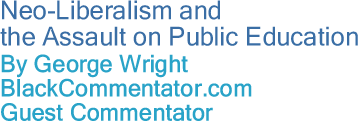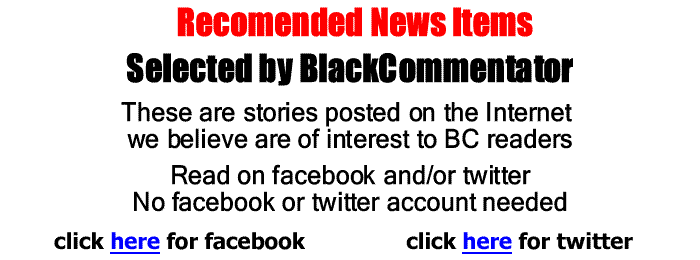
|
||||||||||||||||||||||
|
||
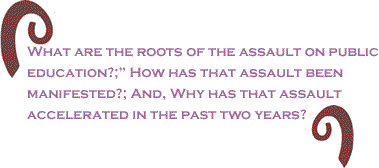 |
||
The
nearly four decade-long effort to restructure public education along
Neo-Liberal guidelines has accelerated since President Barack Obama
assumed office. Neo-Liberalism is an ideology that calls for
�limited government� and a market-driven economy. This project
is being carried out on the federal, state, and local levels, while
targeting publicly-financed K-12 schools and higher education.
On the K-12 level, this agenda has been promoted under the guise of �competitiveness;� �national standards;� �accountability,� �basic skills,� �excellence,� and standardized testing; while the assault on higher education includes budget reductions, �assessments,� �merit pay,� and curriculum reform. The 2008 collapse of the financial system, amplified by chronic overlapping federal, state and local budgetary crises, has provided a �window of opportunity� to intensify this assault.
What are the roots of the assault on public education?;� How has
that assault been manifested?; And, Why has that assault accelerated
in the past two years?
This resultant structural economic crisis caused both stagnant growth and inflation. Simultaneously, United States� post-World War II global economic dominance was being weakened. Causes for this weakening include:
This structural economic crisis led to state and local governments
experiencing chronic deficits, leading to recurring cuts for public
services, including public education.
This model was underscored by massive military spending, providing profits for arms producers and commercial banks.
Implementing the new accumulation model also involved constructing
a new hegemonic ideology that would rationalize the new model.
Thus, Neo-Liberalism was constructed during the 1970�s to serve
that purpose. As David Harvey explains in Neo-Liberalism:
A Brief History, this �consensus building� process involved corporations,
foundations, media, public relations firms, and Republican politicians,
combined with the emerging Right-Wing forces, including the Sun-Belt
wealth, �free-market� economists, anti-tax activists, the Religious-Right,
and Neo-conservatives.
The political implementation of these guidelines aimed to transfer income from the public sector and the working class to the wealthiest people in the country. The Reagan administration institutionalized Neo-Liberalism, a hegemonic ideology which has shaped United States politics since.
The move to restructure public education in the interests of corporate-dominated
Neo-Liberalism came into fruition in 1983 when the Reagan-appointed
National Commission on Excellence in Education issued A Nation at
Risk. The report assessed the decline in student achievement
scores and warned that that decline was an �internal threat that
was more serious than Soviet Union communism.� Using language
not unlike Reagan�s Cold War rhetoric, the report added that, �the
educational foundations of our society are presently being eroded
by a rising tide of mediocrity that threatens our very future as
a nation and as a people.� The report aimed to restructure
the governance, organization, and curriculum of public education.
This would be accomplished by changing educational values and curriculum
goals.
Thus, a new national consensus was being established claiming that
public education was in crisis and that corporate-oriented Neo-Liberal
reforms were necessary. Moreover, the uneven, but persistent,
state and local fiscal crises, which had begun in the 1970�s, continued
to starve public education for resources. The assault on public
education would occur on two-symbiotic tracks: the promotion of
national policy and restructuring owing to budget crises.
Despite the inadequate funding the program received and growing criticism from the education community, NCLB was the law of the land.
The 2008 Presidential election occurred during the worse economic
crisis since the Great Depression. The economic shock devastated
state and local budgets, causing massive reductions in public services,
lay-offs, and housing Obama�s
policy also exposes the conundrum that teacher unions face supporting
the Democratic Party. BlackCommentator.com Guest Commentator George Wright , PhD is the author of The Destruction of a Nation: United States' Policy Toward Angola
Since 1945 |
||
If you would like to comment on this article, please do so below. There is a 400 character limit. You do not need a FaceBook account. Your comment will be posted here on BC instantly. Thanks. Entering your email address is not mandatory. You may also choose to enter only your first name and your location.
|
||
Thank you very much for your readership. |
||
| Any BlackCommentator.com article may be re-printed so long as it is re-printed in its entirety and full credit given to the author and www.BlackCommentator.com. If the re-print is on the Internet we additionally request a link back to the original piece on our Website. | ||
| |
||
April 29, 2010 |
| Executive Editor: David A. Love, JD |
| Managing Editor: Nancy Littlefield |
| Publisher: Peter Gamble |
| Est. April 5, 2002 |
| Printer Friendly Version in resizeable plain text format |
 |
 |
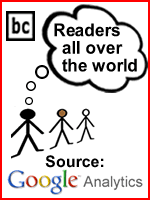 |
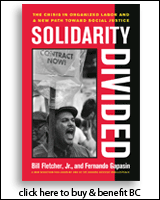
|
 |
| |
| |
































